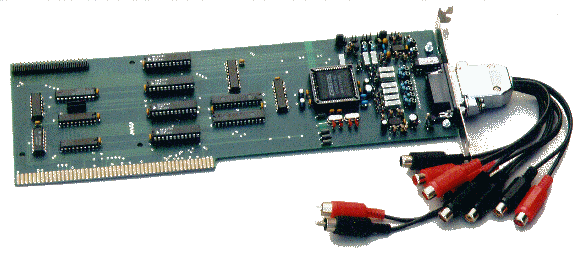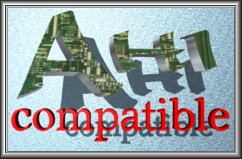


This is the layout of the cable block:
LINE | MIC |AUX1 |AUX2 | OUT
| | | |
L R| GND |L R| GND |L R
---------------------------------
\1o 2o 3o 4o 5o 6o 7o 8o /
\ /
\9o 10o 11o 12o 13o 14o 15o /
---------------------------
GND |L R| GND |L R| GND
| | | |
| | | |
To get more detailed information about timing, pins and technical advice for the unique Prelude feature bus feel free to contact Thomas Wenzel. Here is the pinout for the bus as well as a schematic for asqq.
------------------------
|
.---. | 1: +5V 2: +5V
+5V |o o| +5V | 3: Reset 4: Read/Write
RES |o o| R/W | 5: Clock3 6: Clock1
...Amiga C3 |o o| C1 | 7: AS 8: Ground
Zorro AS |o o| GND | 9: ASQ 10: Ground
Slots ASQ |o o| GND | 11: ASQQ 12: Ground
AQQ |o o| GND | 13: PQ 14: Ground
PQ |o o| GND | 15: ConfigOut 16: Ground
COU |o o| GND | 17: Ser.Rec. 18: Ground
RxD |o o| GND | 19: Clock 20: Ground
CLK |o o| GND | 21: Sync. 22: Audio L to Prelude
Sync|o o| AudL | 23: Ser.Tras. 24: Audio R to Prelude
TxD |o o| AudR | 25: Data 7 26: IRQ from MB
D7 |o o| IRQ | 27: Data 6 28: Address 7
D6 |o o| A7 | 29: Data 5 30: Address 6
D5 |o o| A6 | 31: Data 4 32: Address 5
D4 |o o| A5 | 33: Data 3 34: Address 4
D3 |o o| A4 | 35: Data 2 36: Address 3
D2 |o o| A3 | 37: Data 1 38: Address 2
D1 |o o| A2 | 39: Data 0 40: Address 1
D0 |o o| A1 |
`---´ | Note: Address 0 is not needed since
| the Amiga's Zorro struct doesn't use
| odd addresses.
|
| C1 is twice as slow as 7M, therefor
| C1 and C3 build 7M with
| 7M = C1 XNOR C3
Backside |
of Amiga |
(external) | ASQ is the compliment of DOE
| | (pin93 on Zorro) - "ASDelayed" in
| | other terms.
V |
Le développement de nouveaux modules va rendre cette carte excellente carte encore plus attrayante! Les souhaits des utilisateurs ont été pris en compte, ces modules ouvrent ainsi de nouveaux horizons à la création, à l'édition et au mastering.
ROMBLER
Module interface MIDI pour carte Prelude avec IN/OUT et option Wavwtable (p.ex. pour Yamaha DB-50XG ou autres).
APEGGIATOR
Interface DIGITALIO (SPDIF) pour Prelude avec Mastering 32kHz, 44kHz et 48kHz
MPeGit
DECODER audio MPEG basé sur le hardware layer 1 à 3
MIDI pORTaL
Interface MIDI avec 3 units (3xOUT, 1xIN, 1 Through) en boitier rack 19", raccordement sur tout Amiga, ne necéssite pas de port Seriel ou Parallèle!
Les modules pour la Prelude:
-Rombler l'interface MIDI et WaveTable connector pour la Prelude
![]() The Rombler is a MIDI (GamePort) interface for use with the Zorro
Prelude soundcard. It can be used to connect external MIDI equipment
to the Amiga (using a standard GamePort-MIDI cable), offering IN and
OUT.
The Rombler is a MIDI (GamePort) interface for use with the Zorro
Prelude soundcard. It can be used to connect external MIDI equipment
to the Amiga (using a standard GamePort-MIDI cable), offering IN and
OUT.
It also allows the user to plug a "WaveBlaster" compatible WaveTable board (no ISA or PCI soundcard) into his Amiga, using Prelude's audio mixer to output the sound of the MIDI expander.
Rombler's software consists of an easy to use CAMD driver (CAMD is Commodore's MIDI standard for Amiga, which is supported by actual software) and Tools to play MIDI files from a Shell or the Workbench.
Included is a connector cable (Rombler to GamePort), a bridge to place the interface besides the Prelude (thus allowing to use a WaveTable on the Prelude in a single Zorro slot), assembly documentation and software disk.
-MPEGIt le décodeur MPEG DSP haute qualité pour la Prelude
![]() MPEGIt is a embedded DSP programmed to decode MPEG Audio streams at a
high quality, supporting all currently available bitrates at most
standard frequencies. Decoding is done at a resolution of 24 Bit,
resulting in the best output quality MPEG Audio Layer 1 to Layer 3
can offer.
MPEGIt is a embedded DSP programmed to decode MPEG Audio streams at a
high quality, supporting all currently available bitrates at most
standard frequencies. Decoding is done at a resolution of 24 Bit,
resulting in the best output quality MPEG Audio Layer 1 to Layer 3
can offer.
By using the MPEGIt module Prelude owners can play back MPEG Audio streams at virtually NULL CPU drain at a quality unachieved by any software decoder.
Included in the package is the extended prelude.library offering direct MPEG playback support and a tool to play back MPEG Audio streams from WorkBench or Shell.
Music Melt
Le nouveau soft professionel, Sampling, enregistrement des projets en RAM ou sur HD, édition destructrice des projets, grâce au projets virtuels. High-end Miking fonction, studio FFT, technique PunchIN-PunchOUT, support PPC...
Prelude1200 Press Information Audio Hardware for Amiga 1200 computers
Finally, after three months of developing, Prelude1200 is now in production and will be available at your favorite Amiga dealer soon. Thomas Wenzel designed this new product for A.C.T., creating the new standard sound hardware for all Amiga1200, no matter whether with or without Zorro2 bus.
Prelude1200 will be produced industrially since orders already pile up high, making manual soldering impossible. It has become clear that Prelude1200 is the product the Amiga1200 world has been waiting for! Fitting completely into a standard desktop Amiga1200 without the customer having to execute more difficult tasks than opening the case, plugging the card in and closing everything again, being designed in SMD (of course - due to mechanical reasons) and using the professionally approved high quality Codec by Crystal Semiconductors, that is used by the famous TerraTec Maestro cards as well as other big sellers we are sure to provide our customers with the quality in sound, design and support an Amiga user expects from new products.
Industrial production, the use of known to be working components, the 100% software compability to the known Prelude Zorro board allows us to offer Prelude1200 at an unbeatable price including an interesting bunch of software (see below).
Of course Prelude1200 supports AHI, but even more important: you can use all Prelude native tools like TAPEDECK, GMX and many others right from the start. So PPC support is already here and a line up of third party products support this hardware (Camouflage, Samplitude Opus, soon Fusion - more to come soon!). There is also a minimum Toccata emulation, allowing Prelude1200 to be used in some applications that offer Toccata support.
Like the Prelude Zorro version three stereo inputs can be sampled from, one additional input can be mixed (which is useful for Paula Audio). A CDRom drive can be internally connected.
There is no cable bunch needed to access the Prelude1200 from outside since its inputs and outputs are adressable through 3.5mm stereo plugs. All technical data that apply to the Prelude Zorro version also are correct for Prelude 1200 except for the hardware expansion capabilites (Prelude1200 being not expandable): 16Bit resolution ( 8 Bit, ADPCM, uLaw, ALaw also supported), 5kHz up to 64kHz(!) with correct frequency supply for 44.1kHz and 48kHz (no resampling, no jitter due to wrong Quarz components), low CPU usage thanks to FIFOs, easy to use native library, Full Duplex (Record/Playback simultaneously).